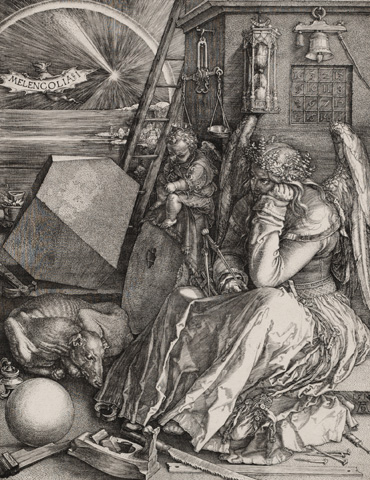
"Melencolia I" (1514) by Albrecht Dürer, part of a current exhibit at the Cleveland Museum of Art (Courtesy of Cleveland Museum)
The Virgin, enthroned, closes her eyes and tilts her head to the side slightly as she wears a crown in Albrecht Dürer's 1485 drawing "Madonna with Musical Angels." The infant Jesus, naked and with rays of light emanating from his head, stands on Mary's lap as two angels serenade the pair with a lute and a medieval harp.
The German artist's drawing succeeds particularly for its build up, through cross-hatching, of the details in the folds of the Virgin's and the angels' garments and in their hair, while elsewhere Dürer employed a lighter touch. A carefully balanced tug of war between the work's different elements keeps the eye from straying from the important details.
It's probably worth mentioning at this point that Dürer (1471-1528) was only 14 years old at the time he drew it. And he had already executed a well-drawn self-portrait the previous year. "Madonna with Musical Angels" foreshadowed what would prove a productive career of religiously themed works.
A new exhibit at the Cleveland Museum of Art titled "Dürer's Women: Images of Devotion & Desire" (open through Sept. 28) focuses on more than 50 of Dürer's works from the museum's collection that contain female subjects. As the title reveals, those women were often saintly.
"Many of Dürer's most captivating prints are devoted to both religious and secular women. The Virgin Mary was foremost among these women, and his images of her are for the most part traditional in nature," said Dana Cowen, who curated the Cleveland exhibit and whose dissertation focused on the artist's late works. "Dürer emphasized such characteristics as her purity, chastity and devotion, but most significantly her humanity and role as a mother, both aspects of which furthered her accessibility to a widespread audience."
Alternatively, Dürer's prints -- which depict women as protagonists or as supporting actors -- are generally "more obscure and esoteric, particularly those featuring nudity," according to Cowen. Those works, she said, address themes ranging from good versus evil to the dangers of love and temptation.
Throughout his career, Dürer continually returned to the theme of the Virgin and Child, and produced a series of 20 woodcuts on the life of the Virgin. The images of the Virgin and Child "correspond with the devotional atmosphere prevalent in Northern Europe during the period prior to the Reformation," Cowen said.
Amanda Luyster, a lecturer in the visual arts department at College of The Holy Cross in Worcester, Mass., agrees that the artist focused heavily on Catholic subjects.
"Much of Dürer's earlier, and well-known, work is heavily meaningful to a Catholic audience, focusing as it does on themes like the Virgin and Child and the Apocalypse," she said. "It has been suggested that Dürer's own fears regarding his future salvation, given dreadful form, are what made his printed series of the Apocalypse so popular."
Dürer's drawing "Praying Hands" may be his best-known work, particularly since it began surfacing in clip art computer programs. But his highly detailed Apocalypse series (1498), which show the Four Horsemen trampling men underfoot here and an appropriately terrifying seven-headed dragon there, are also recognized widely.
If Dürer's apocalyptic visions are the stuff that nightmares are made of, his depictions of women are "intelligent, complex and immensely appealing," according to Luyster.
"One of the things that attract me to Dürer's women is that he shows us so many different kinds of women, just as there are so many different kinds of women in real life," she said. Not only did he repeatedly depict the Virgin, but he also drew his own mother and his wife. "Those drawings are touching, too, both detached and loving at the same time," Luyster said.
Dürer also seems to have been popular with the ladies of his day. In a 1507 letter, one of Dürer's contemporaries noted that his horoscope implied "success with women," and he was said to have wanted to attract women with his beard, Luyster notes. One of Dürer's friends wrote that both "whores and pious women" in Nuremberg had been asking after him.
In 1493, Dürer drew the first nude life drawing by a German artist. He was both "fascinated by the female body in the artistic sense," according to Luyster, and "intrigued by classical proportions for bodies both male and female." The artist's interest in human proportion is immediately clear from his 1504 engraving "Adam and Eve," which is in the exhibit, even if the original couple is depicted in an unnaturally muscular fashion.
"This engraving is also fascinating because of its inclusion of animal symbols of the four human temperaments, transforming the idea of sin -- often visually borne by Eve alone -- into a much broader concept that bears upon both genders and their changing natures," Luyster said.
Dürer's "Melencolia I" (1514), which also appears in the exhibit, depicts a seated and winged woman (melancholy) with a laurel wreath in her hair. Her head rests on her hand in a pose best described as a more depressed version of Auguste Rodin's "The Thinker," and she is surrounded by a variety of accessories, including an hourglass (the passage of time), scales and a bell.
"Immobilized by her lack of creativity, the winged goddess sits dispiritedly surrounded by the tools and instruments she has lost the inspiration to use," according to the Cleveland Museum website. "Among intellectuals, melancholy was often associated with introspective, educated people, even genius."
The etching always seemed so "mannish" to Luyster. "I find it fascinating that this broad, capable, strong and brooding body too is a female if not necessarily feminine form," she said. " 'Melencolia' fits with a long tradition of rendering abstract concepts as female personifications, but she also fits with very up-to-date notions circa 1500 of intellectual and scientific advancement."
The figure of melancholy has been interpreted as suggesting an intellectual path through art to salvation, according to Luyster. "Whether through sin, through love, or through the intellect, Dürer's women have the power to captivate us and to provide a glimpse of the rich and shifting world that Dürer and other real men and women inhabited around the year 1500," she said.
Although Dürer grew up Catholic and many of his works undoubtedly reflect a Catholic perspective, the artist went to Augsburg in 1518 and met Martin Luther. (Luther had written his 95 Theses the previous year.) Dürer, according to Encyclopedia Britannica, become a "devoted follower of Luther," although others question how deeply his sympathies with Luther lay.
An article by Dan Graves on Christianity.com claims that Dürer -- who wrote in his diary when Luther was in danger, "O God, if Luther is dead, who will henceforth explain to us the Gospel?" -- never left the Catholic church. "He could not abandon the faith of his deeply pious parents," Graves writes.
"Engraving was invented by Albrecht Durer, a Catholic priest," declares an 1890 article titled "Is it true that the Catholic church is the enemy of progress?" in the Massachusetts paper Sacred Heart Review, which makes no mention of Luther. But Lutherans "have discovered a kindred spirit in Dürer," states an article in the theology journal Word & World. "The Dürer of 1498 was a 'good Catholic,' but by 1522 his sympathies were clearly with Luther."
For her part, Luyster said it's known that the artist was sympathetic to Luther, although he "also thought deeply about his own religiosity and wrote passionately about his own beliefs, including his conviction that art could and should continue to play a role in expressing faith."
Luther, after all, had advocated "a more limited role for art, due to fears of religious art leading to idolatry," she noted.
[Menachem Wecker is the former education reporter at U.S. News & World Report. His book, Consider No Evil: Two Faith Traditions and the Problem of Academic Freedom in Religious Higher Education, co-authored with Brandon Withrow, will be published this summer by Cascade Books.]



